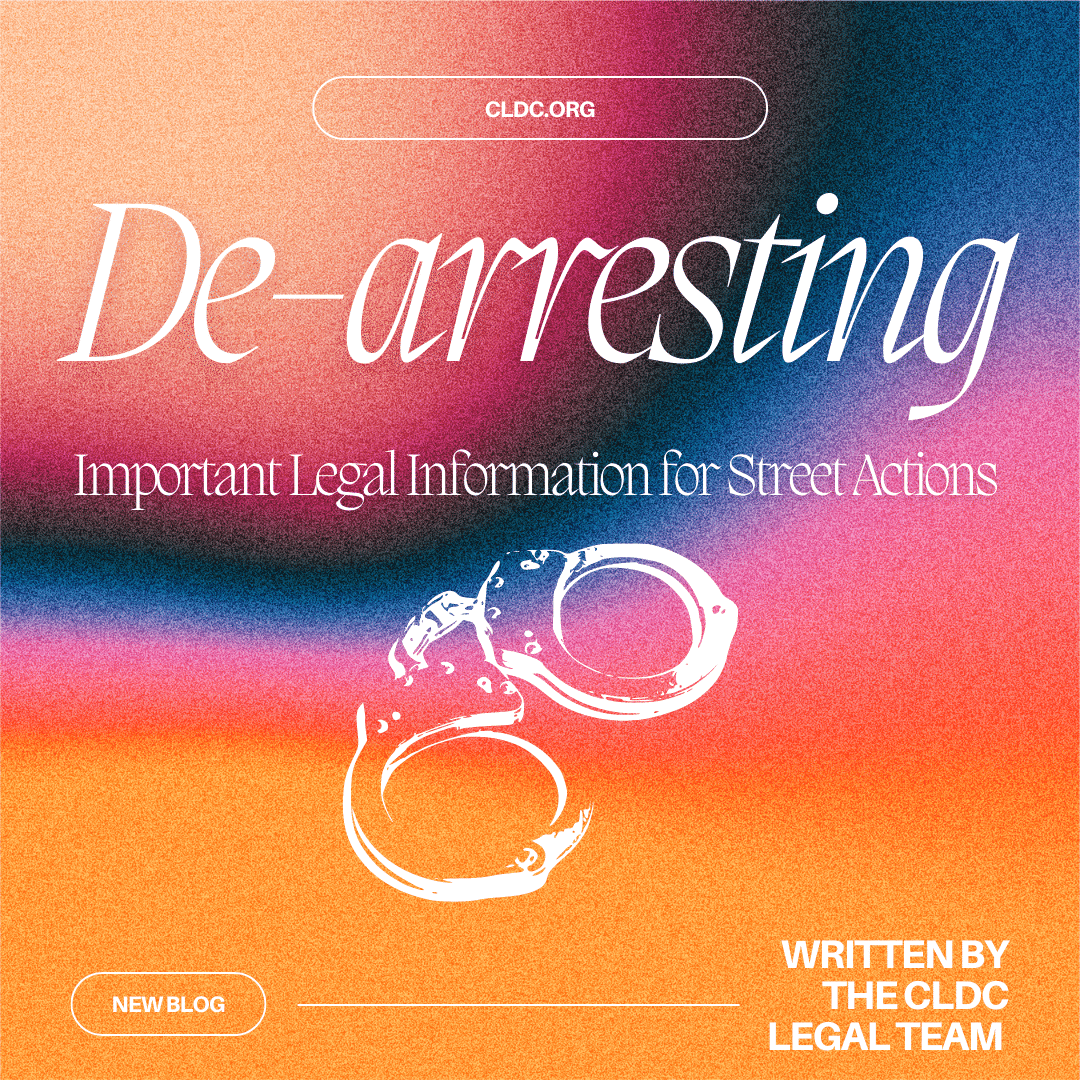De-Arresting: Important Legal Information for Street Actions
Since the George Floyd Uprisings that began in May 2020, the tactic of “de-arresting” (attempting to return arrestee(s) from police custody) has received increased attention in the media and scrutiny from the eyes of law enforcement across the United States.[1] Yet, de-arresting is not new. Across movements and history, there are clear instances of people taking decisive action to help others gain freedom from state confinement. During World War II many people worked together to help imprisoned people escape from Nazi concertation camps.[2] In the 19th century, abolitionist activists actively worked to help people escape slavery in the American south.[3] In the 1960’s Black communities in the United States used de-arresting as a means of self-defense when faced with systemically abusive and racist police departments.[4]
More recently, anti-capitalist and anti-globalization protestors combined de-arresting with “black bloc” tactics (wearing black clothing, face and head coverings to conceal individual identities) to effectively remove comrades from the clutches of police during the shutdown of the World Trade Organization in Seattle in 1999. In the mid-90’s, during the height of the timber wars in the West, forest defenders became adept at slipping out of federal law enforcement custody and back into the trees[5]. Both before and after 2000, Anti Racist Action trained on de-arresting tactics during street clashes all over the US. Contemporary anti-racist and anti-fascist movements in the United States have continued to use this tactic,[6] sometimes to great success,[7] as have activists across the world who engage in direct struggles with law enforcement.[8]
Of course, in each of these instances, de-arresting has posed real risks. Historically and today, state confinement is often deemed legal, de-arresting is often deemed illegal, and those attempting de-arrests have risked social and financial penalties, imprisonment, physical injury, and even death.
Underlying the tactic of de-arresting is the truth that what is legal is not always right. For many people, arrest means not only that they will face an unjust and racist criminal system, but that in the process of being detained they may be subjected to extra-judicial violence, abuse, and even death[9]. The recent murders of unarmed people, primarily from intentionally exploited communities, caught on cellphone cameras and posted on the internet, made it harder to deny and undermine the truth of police violence against BIPOC (Black, Indigenous, People of Color) and others.
That said, de-arresting carries a spectrum of possible legal and pragmatic consequences for both the person being arrested and the person(s) trying to perform a de-arrest. We have created this guide to inform folks of the current potential legal risks so they have knowledge and consent when considering deployment of this tactic.
Potential criminal legal risks
Let’s be clear: attempting to de-arrest or un-arrest someone in cop custody or otherwise interfering with an arrest is almost always a crime (limited exceptions are addressed below). In some places, interfering with a cop’s duties, including arrest, is charged as a misdemeanor, while in other places it may be a felony.[9] In some places, simply touching a cop could result in charges like harassment or assault. Should a cop be harmed in a de-arrest situation, even minimally, this can escalate the charges against the person who allegedly caused the harm. And if a cop is seriously injured (a standard that changes depending on what jurisdiction you are in) that can result in a felony instead of a misdemeanor charge, and/or a longer jail or even prison sentence[10]. Collective group action may also bring the risk of riot charges (which can be a felony or misdemeanor, with different definitions of the “criminal action,” depending on the jurisdiction).
Additionally, if someone de-arrested from cop custody runs or tries to run, they may be charged with fleeing or escape if caught. Aiding and abetting an escape, or conspiracy to interfere with an arrest or escape are also potential misdemeanor or felony criminal consequences that can arise from one or more people acting to de-arrest another person.
Charges such as fleeing, assaulting a cop, or escape, are not great charges to have—you may have a harder time getting released from jail pre-trial, pay higher bail and/or harsher release conditions; not to mention you will often face longer jail and probation sentences if convicted by a judge. In addition, jail cops and guards may retaliate, impose higher security restrictions, and/or use excessive shackling of a person charged with assaulting a cop. Convictions for these types of crimes can also pose particular problems. While any felony conviction may hinder future economic opportunities, having a conviction that says, “I fight cops” or “I run from cops” on your record will likely impact future interactions you have with Officer Friendly.
Potential defenses to criminal charges
A person is not guilty unless and until proven guilty at a trial where twelve[11] jurors hear evidence and then unanimously find you are guilty beyond a reasonable doubt. At trial, the person accused has an opportunity to present defenses to the jury. One common defense in de-arresting cases is “defense of others,” which is akin to self-defense. Generally, defense of others requires you to show that your actions were reasonably intended to protect another person from an imminent use of unlawful force and, often requires you to show the force you used was reasonable under the circumstances. This defense is an incredibly heavy and high burden in de-arrest cases where the alleged victim is a cop. This is because you may need to prove that you reasonably believed the cop was about to unlawfully seriously injure or kill someone—and remember, depending on the circumstances, cops can lawfully injure or kill people.
Assessing Risks
Cops receive numerous worst-case scenario, fear-based trainings, in which they are programmed to expect a lethal attack at any moment and be ready to “defend themselves” at all costs.[12] Because they are trained to believe they are a target for violence, cops will likely perceive (or at least claim to perceive) a de-arrest as personally threatening and thus a justification for using force, even lethal force. For example, even inadvertent contact with a cop’s array of weaponry strapped around their waist could be construed as an attempt to take the cop’s weapon to use against them, thus justifying escalated use of force, including potentially deadly force.
This escalated force poses a threat not only to the person(s) trying to de-arrest someone, but also to the person being arrested– as well as any other activists on the scene who may now face adrenalized cops more likely to use violence. A de-arrest may take an event or action to a new threat level, including a level that others may not be prepared for and may not have consented to. A de-arrest may also cause police to adjust their tactics not only in the moment, but at future events or actions, where it is used to justify more cops and faster escalation when responding to a crowd.
Unless you consulted with the person beforehand, it also may not be possible to know whether the person being arrested consents to their de-arrest, including these potential escalated and long-term risks. It is also important to consider that even if a de-arrest is successful, a police officer may still initiate prosecution—including facilitating the issuance of an arrest warrant where cops swoop in and arrest the person later when they are away from their community—if they already know the person’s name or have their identification information.
Finally, with the prolific live-streaming that now occurs at most street protests, combined with private security cameras on stores and homes, and body cameras on more and more cops, the chances of everyone’s identity being captured on video has increased exponentially—including the person being arrested and the person(s) attempting the de-arrest. This is especially true if police seek to target a specific individual, like a lone de-arrester. Video allows cops to hunt and sift through images in an attempt to identify someone long after the action.
Civil lawsuit considerations
When the police violate a person’s rights by illegally detaining them or using excessive force, it may be possible for that person to sue the police in a civil lawsuit. If you participated in a de-arrest attempt, and one or more people are injured by the police, it’s more likely the cops will claim their use of force was not excessive, but instead was justified, in response to your actions. In deciding whether force is excessive or “reasonable,” courts look at several factors, including the danger the cops thought they were facing and whether the person was resisting or tried to flee from arrest. As a result, the risk of a judge dismissing an excessive force lawsuit may increase as a result of a de-arrest situation. In addition, cops may claim that a person’s injuries were caused by the folks trying to de-arrest, which may turn a judge and jury’s attention from the cops’ bad behavior to the conduct of the de-arresters. It is also important to note that if a person is convicted of crimes like resisting arrest, interfering with police, assault, escape, or fleeing, that could eliminate or greatly reduce your ability to file a lawsuit for excessive force or unlawful arrest.
Conclusion
CLDC seeks to ensure our movements, communities, and affinity groups engage in knowing, consensual actions with each other, and that folks are prepared and knowledgeable about the legal consequences of any action they take. Our solidarity with the movements we work with is based on respect for a diversity of tactics– see the St. Paul’s Principals for more on that.[13] Knowledge is power. Assert your rights, we’ve got your back.
Notes:
[1] https://www.mic.com/articles/145118/one-of-the-leaders-of-the-black-lives-matter-movement-has-been-charged-with-lynching; https://www.nbcnews.com/news/us-news/de-arrests-leaf-blowers-portland-protesters-find-new-ways-stand-federa-rcna61; https://www.desmoinesregister.com/story/news/crime-and-courts/2022/08/17/des-moines-city-council-indira-sheumaker-counterclaim-police-protest-arrest/10341748002/; http://www.fightbacknews.org/2022/5/9/ban-our-bodies-protest-ended-homeland-security-lapd-attack
[2] https://www.auschwitz.org/en/history/resistance/escapes-and-reports/
[3] http://www.d-long.com/eWebEditor/uploadfile/2019110809031560964641.pdf
[4] https://eastcoastrenegades.wordpress.com/2012/11/09/riot-a-philadelphia-chronology-1938-1964/
[5] https://www.hcn.org/issues/170/5496
[6] https://crimethinc.com/2017/02/19/resistance-repression-and-media-lies-in-philadelphia-reportback-from-the-black-resistance-march-21717;https://crimethinc.com/2017/08/31/a-non-student-in-the-student-movement-seven-years-of-student-struggles-in-atlanta;https://crimethinc.com/2020/08/03/tools-and-tactics-in-the-portland-protests-from-leaf-blowers-and-umbrellas-to-lasers-bubbles-and-balloons
[7] https://www.nola.com/gambit/news/the_latest/article_650244ca-ac41-11ea-b69a-ef570f9ecae2.html
[8] https://crimethinc.com/2020/10/15/chile-looking-back-on-a-year-of-uprising-what-makes-revolt-spread-and-what-hinders-it;https://crimethinc.com/2017/04/19/from-the-loi-travail-to-the-french-elections-a-retrospective-on-social-upheaval-in-france-2015-2017
[9] https://leginfo.legislature.ca.gov/faces/codes_displaySection.xhtml?sectionNum=405A.&lawCode=PEN
[10] In most states, a felony means a convicted person may serve a year or more in prison, while a misdemeanor conviction means less than a year in jail.
[11] In most jurisdictions, twelve jurors sit on the jury at felony trials, six for most misdemeanor trials. Some states have a misdemeanor classification that does not trigger the right to a trial by jury and the verdict will be decided by a judge; a.k.a “bench trial.”
[12] https://www.startribune.com/fear-based-training-for-police-officers-is-challenged/487958041/; https://harvardlawreview.org/2015/04/law-enforcements-warrior-problem/ ; https://gen.medium.com/fearing-for-our-lives-82ad7eb7d75f ; https://www.insider.com/bulletproof-dave-grossman-police-trainer-teaching-officers-how-to-kill-2020-6
[13] https://neighborhoodanarchists.org/st-paul-principles-flyer/

